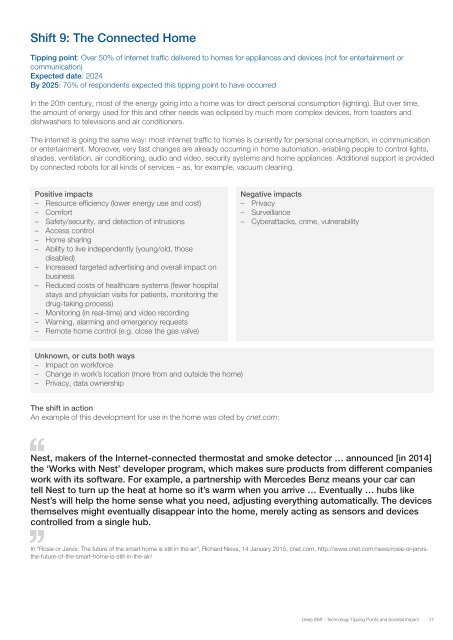Deep Shift Technology Tipping Points and Societal Impact
WEF_GAC15_Technological_Tipping_Points_report_2015
WEF_GAC15_Technological_Tipping_Points_report_2015
- No tags were found...
Create successful ePaper yourself
Turn your PDF publications into a flip-book with our unique Google optimized e-Paper software.
<strong>Shift</strong> 9: The Connected Home<br />
<strong>Tipping</strong> point: Over 50% of internet traffic delivered to homes for appliances <strong>and</strong> devices (not for entertainment or<br />
communication)<br />
Expected date: 2024<br />
By 2025: 70% of respondents expected this tipping point to have occurred<br />
In the 20th century, most of the energy going into a home was for direct personal consumption (lighting). But over time,<br />
the amount of energy used for this <strong>and</strong> other needs was eclipsed by much more complex devices, from toasters <strong>and</strong><br />
dishwashers to televisions <strong>and</strong> air conditioners.<br />
The internet is going the same way: most internet traffic to homes is currently for personal consumption, in communication<br />
or entertainment. Moreover, very fast changes are already occurring in home automation, enabling people to control lights,<br />
shades, ventilation, air conditioning, audio <strong>and</strong> video, security systems <strong>and</strong> home appliances. Additional support is provided<br />
by connected robots for all kinds of services – as, for example, vacuum cleaning.<br />
Positive impacts<br />
––<br />
Resource efficiency (lower energy use <strong>and</strong> cost)<br />
––<br />
Comfort<br />
––<br />
Safety/security, <strong>and</strong> detection of intrusions<br />
––<br />
Access control<br />
––<br />
Home sharing<br />
––<br />
Ability to live independently (young/old, those<br />
disabled)<br />
––<br />
Increased targeted advertising <strong>and</strong> overall impact on<br />
business<br />
––<br />
Reduced costs of healthcare systems (fewer hospital<br />
stays <strong>and</strong> physician visits for patients, monitoring the<br />
drug-taking process)<br />
––<br />
Monitoring (in real-time) <strong>and</strong> video recording<br />
––<br />
Warning, alarming <strong>and</strong> emergency requests<br />
––<br />
Remote home control (e.g. close the gas valve)<br />
Negative impacts<br />
––<br />
Privacy<br />
––<br />
Surveillance<br />
––<br />
Cyberattacks, crime, vulnerability<br />
Unknown, or cuts both ways<br />
––<br />
<strong>Impact</strong> on workforce<br />
––<br />
Change in work’s location (more from <strong>and</strong> outside the home)<br />
––<br />
Privacy, data ownership<br />
The shift in action<br />
An example of this development for use in the home was cited by cnet.com:<br />
Nest, makers of the Internet-connected thermostat <strong>and</strong> smoke detector … announced [in 2014]<br />
the ‘Works with Nest’ developer program, which makes sure products from different companies<br />
work with its software. For example, a partnership with Mercedes Benz means your car can<br />
tell Nest to turn up the heat at home so it’s warm when you arrive … Eventually … hubs like<br />
Nest’s will help the home sense what you need, adjusting everything automatically. The devices<br />
themselves might eventually disappear into the home, merely acting as sensors <strong>and</strong> devices<br />
controlled from a single hub.<br />
In “Rosie or Jarvis: The future of the smart home is still in the air”, Richard Nieva, 14 January 2015, cnet.com, http://www.cnet.com/news/rosie-or-jarvisthe-future-of-the-smart-home-is-still-in-the-air/<br />
<strong>Deep</strong> <strong>Shift</strong> - <strong>Technology</strong> <strong>Tipping</strong> <strong>Points</strong> <strong>and</strong> <strong>Societal</strong> <strong>Impact</strong><br />
17











